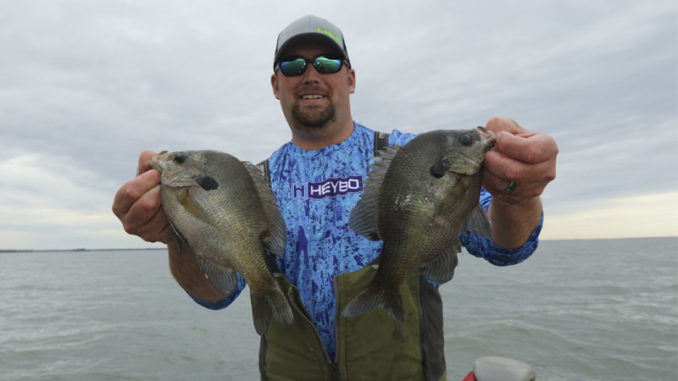
Carolina anglers are very familiar with bluegill
Bluegills (Lepomis macrochirus) are one of the most popular and populous fish in America. And for many anglers, it’s the very first fish they ever caught. Fisheries experts describe them as “laterally compressed, or flattened sunfish.”
Depending on the water color and quality they are found, bluegills can range from almost solid black to olive in color with orange or yellow breasts. Vertical bars sometimes stand out on their sides. Their fins appear clear, except for a distinguishing black smudge on the bottom of the rear of the dorsal fin. Along with its black earflap, that black smudge is the surest way to identify it from some other members of the sunfish family.
As the name implies, these fish often — but not always — have blue to violet coloring on their gills and throughout the top portion of their bodies. This is most evident among breeding males.
The bluegill is native to the eastern portion of the United States. And it exists nationwide thanks to stocking programs. It is one of the most-commonly stocked fish in ponds and lakes. They are a favorite among anglers, especially those who like to fish the old fashioned way with live bait under a cork.
These fish are highly tolerant of a wide range of habitat. Small ponds, creeks, rivers, swamps, oxbow lakes, retention basins, and drainage ditches are all suitable for bluegills. Anglers often find them close to some type of structure, including flooded vegetation, tree stumps, downed timber, rock walls, and sunken debris.
Anglers find their share of bluegills in mostly shallow water during the warm months. And many anglers don’t fish for them during winter. However, those that do, often find them as deep as 60 feet in lakes.
These fish have huge appetites
Bluegills aren’t too picky about what they eat. Insects of all sizes, small invertebrates, crawdads, freshwater mussels, grass shrimp and tiny fishes make up their diets. Their mouths are fairly small, which limits their choices of eating.
Live crickets are among the most popular baits for bluegill anglers. Live red worms, nightcrawlers, waxworms, and catalpa worms will also draw strikes. Small crawdads are excellent baits, but not widely available at bait shops. Small spinners, tiny crankbaits, and artificial flies also work great.
Bluegill colonies are often made up of as many as 100 circular nests. Safety in numbers seems to be their motto. Their huge colonies help protect their eggs and fry from predator fish. They spawn throughout many months, as long as the water temperature is at least 75 degrees. In the south, this usually lasts from May through August, and sometimes into September.
Female bluegills can lay up to 80,000 eggs in a year. And they often deposit eggs in several different nests. Males, likewise, spray their sperm in multiple nests. The bluegill is the only species of sunfish that do this. The males guard the colonies until the fry disperse.
Bluegills are often called bream, sunfish, sunny, blue sunfish, coppernose, and blue perch. Anglers sometimes confuse them with redear sunfish a/k/a shellcrackers, and with green sunfish and redbreast sunfish.
S.C., N.C. state and world records
The South Carolina state record bluegill weighed 3 pounds, 4 ounces. J.P. Hegler of Heath Springs, S.C. caught the fish in Lancaster County in 1973. North Carolina’s state record weighed 4 pounds, 5 ounces. Travis Jackson caught it on July 27, 1967 in Henderson County.
The world record bluegill weighed 4 pounds, 12 ounces and was caught by T. Hudson in Ketona Lake, Alabama on April 9, 1950. Not only is that fish the world record, but is also the oldest recorded bluegill record in any state.





Be the first to comment